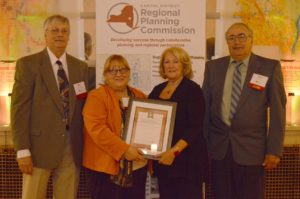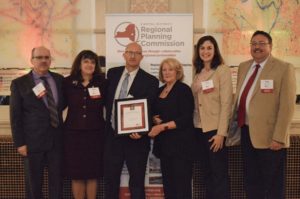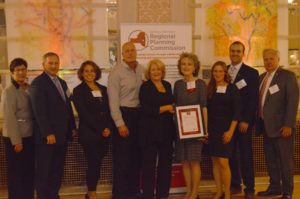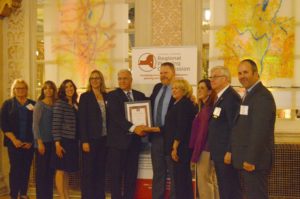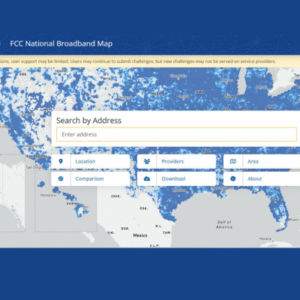Capital District Regional Planning Commission Announces 2017 Erastus Corning Achievement Awards
The Capital District Regional Planning Commission (CDRPC) is pleased to announce the winners of its 2017 Erastus Corning, 2nd Achievement Awards for Intermunicipal Cooperation. Five cooperative initiatives by organizations representing more than a dozen municipalities in the Counties of Albany, Rensselaer, Saratoga and Schenectady were recognized during CDRPC’s 50th Anniversary Celebration Dinner on October 18, 2017.
The Erastus Corning, 2nd Awards recognize municipalities and organizations whose efforts have significantly contributed to the advancement of intermunicipal and interagency cooperation and regional planning. The 2017 award-winning initiatives, municipalities and organizations include: the Stormwater Coalition of Albany County, the Town & Village of Stillwater, the Champlain Canalway Trail Working Group and Hudson Crossing Park, the Regional Shared Transportation Initiative, and the Tri-County Interoperable 911, Telecommunications, Computer-aided Dispatch, and Records Management Network.
“These award-winning initiatives demonstrate the value and benefits of working together and resonate with CDRPC’s long-standing commitment to promoting regional cooperation,” said Judith H. Breselor, AICP, Chair of CDRPC’s Board of Commissioners. “We are pleased to recognize these projects and organizations through this awards program and will continue to support similar collaborations that provide services more efficiently, enhance community and economic development, help protect environmental resources, and enhance our quality of life in the Capital District.”
The awards are named in honor of the Commission’s first Chairman, Erastus Corning, 2nd, Mayor of the City of Albany from 1942-1983, and recognize initiatives that involved at least two local jurisdictions or entities within the four-county region of Albany, Rensselaer, Saratoga or Schenectady in New York’s Capital Region.
A brief description of each of the programs receiving awards follows, listed alphabetically:
Champlain Canalway Trail Working Group and Hudson Crossing Park
During the last five years, the vision of a trail linking communities along the Champlain Canal corridor moved closer to reality thanks to the work of the Champlain Canalway Trail Working Group (CCTWG), and Hudson Crossing Park (HCP). While the ideal trail route is along the original canal, ownership of much of the corridor has been divided among multiple parties, mostly municipalities, over the last century. The CCTWG and HCP have provided the impetus for grass-roots intermunicipal cooperation and laid the groundwork for success. Due the groups’ collaborative work and planning, $12 million dollars of Empire State Trail funds has been made available to complete three major sections of the Champlain Canalway Trail in Saratoga County.
Regional Shared Transportation Initiative
Capital Region BOCES, Niskayuna, Burnt Hills-Ballston Lake, Scotia-Gleville and Mohanasen School District
The Capital District school districts, Niskayuna, Burnt Hills-Ballston Lake, Scotia-Glenville and Mohonasen, in partnership with Capital Region BOCES, collaborated regionally to form a shared busing system. The collaboration formed 18 shared bus routes to out-of-district destinations resulting in significant savings for the school districts and their taxpayers. Their innovative work has also contributed to regional advancement as more districts are adopting their cooperative busing system to realize cost savings and environmental benefits.
Stormwater Coalition of Albany County
City of Albany, Town of Bethlehem, City of Cohoes, Town of Colonie, Village of Colonie, Village of Green Island, Town of Guilderland, Village of Menands, Town of New Scotland, City of Watervliet, Albany County, and the University at Albany
The Stormwater Coalition of Albany County is a model of intermunicipal cooperation. Coalition staff provide resources to eleven municipalities to ensure they are compliant with the Clean Water Act and SPDES permits. The Coalition works to author joint stormwater management plans, encourages best practices, performs public outreach, and helps ensure cost effective stormwater management programs are in place for their constituents. Nancy Heinzen and her staff have implemented cutting edge mapping, delivered several educational presentations for advocates and policy makers, and have taken on a laudable job of protecting water quality throughout Albany County.
Town & Village of Stillwater Route 4 Form-Based Code
Town of Stillwater, Village of Stillwater, Capital District Transportation Committee, and Planning4Places, LLC with the Chazen Companies
The Town and Village of Stillwater, in partnership with the Capital District Transportation Committee, collaborated to develop zoning code changes and design standards for both the Town and Village along the Route 4 corridor. The Form-Based Code (FBC) effort is the most recent example of intermunicipal cooperation. This project appears to be the only one of its kind adopted in the Capital Region. In fact, this code is one of the few adopted FBCs in New York State and one of about a dozen regional FBCs in the country.
Tri- County Interoperable 911 Telecommunications, Computer-aided Dispatch, and Records Management Network
Albany County Sheriff Craig Apple, Sr, Rensselaer County Sheriff Patrick A. Russo, Saratoga County Sheriff Michael H. Zurlo, Albany County Executive Daniel McCoy, Rensselaer County Executive Kathleen M. Jimino, Saratoga County Board of Supervisors Chairman Edward D. Kinowski
Albany, Rensselaer, and Saratoga counties have come together to develop and implement a shared E-911, computer-aided dispatch, mobile applications and records management system. The ability to seamlessly share information on this robust system enhances service delivery and creates efficiencies for all participating agencies. This initiative provides significant improvements to public safety, as well as cost savings for each participating agency.
Nominations were reviewed by a Committee appointed by the CDRPC Chair and evaluated using the following criteria: a) Demonstration of actual or potential improvement, efficiency, or cost-savings as the result of the cooperative project or activity of individual; b) Creation of new institutional capacity to solve a local or regional problem; c) Community involvement and support; and d) Degree of innovative solutions to overcome challenges. The committee included representatives from the Capital District Planners Association, Capital District Transportation Committee, University at Albany Department of Geography and Planning, the New York Planning Federation and CDRPC.
